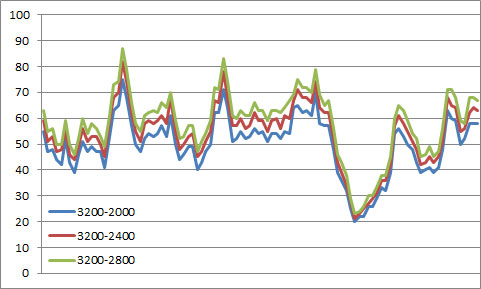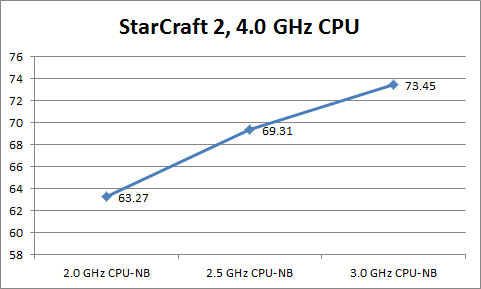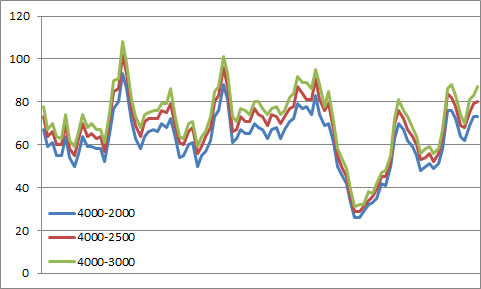ASRock 890FX Deluxe: Comprehensive Motherboard Review & Investigation of Thuban Performance Scaling
by Rajinder Gill on August 31, 2010 7:00 AM EST- Posted in
- ASRock
- AMD
- Motherboards
- 890FX
To find out how the CPU-NB affects the performance, we picked three data points each for our 1090T’s stock frequency (3.2 GHz) and for overclocked frequency (4.0 GHz). Ideally we wanted to control memory ratio, frequencies and timings, but the data size became quickly too large for this review. In the end we decided on some of the key data points so that users can easily understand the impact of the CPU-NB and memory configuration on this platform. For these tests, we disabled Window’s power saving features and 1090T’s Turbo Core. Keep in mind that these tests were not performed as a comparison between different products, so the data here cannot be directly compared to numbers you may see elsewhere. Games were run at 1680x1050 in full-screen mode with maximum in-game settings. AA and AF were disabled.
Stock Configuration (1090T, 3.2 GHz)
3200-2000: CPU 3.2 GHz, 16x200 | CPU-NB 2.0 GHz, 10x200 | 2x2GB DDR3-1066/CL5
3200-2400: CPU 3.2 GHz, 16x200 | CPU-NB 2.4 GHz, 12x200 | 2x2GB DDR3-1333/CL6
3200-2800: CPU 3.2 GHz, 16x200 | CPU-NB 2.8 GHz, 14x200 | 2x2GB DDR3-1600/CL7Overclocked Configuration (1090T, 4.0 GHz)
4000-2000: CPU 4.0 GHz, 16x250 | CPU-NB 2.0 GHz, 8x250 | 2x2GB DDR3-1333/CL6
4000-2500: CPU 4.0 GHz, 16x250 | CPU-NB 2.5 GHz, 10x250 | 2x2GB DDR3-1666/CL7
4000-3000: CPU 4.0 GHz, 16x250 | CPU-NB 3.0 GHz, 12x250 | 2x2GB DDR3-2000/CL8


The 7-Zip benchmark does set the trend of what’s to come. Note we had to stretch the charts in order to keep the numbers legible. It looks like the performance gain is almost linear at 3.2 GHz while it tapers off somewhat as we raise the CPU-NB from 2.5 GHz to 3.0 GHz at the core frequency 4.0 GHz. The improvements from the default CPU-NB frequency 2.0 GHz ring at 3.5% and 5%, respectively.
X264 HD 3.0 Benchmark


We ran the latest version of X264 HD 3.0 benchmark five times, and averaged the middle three scores. X264 HD 3.0 benchmark results are interesting. We see slightly better scaling than 7-Zip for the 1st pass (FPS increases by 4.2% and 5.4%, respectively) , but the improvement in 2nd pass was almost non-existent. We are starting to wonder whether it is worth raising the CPU-NB frequency because the gain pales in comparison to the gain made by increasing the core frequency. Simply overclocking the CPU core by 25% without touching the CPU-NB got us 20% performance improvement in the 2nd pass.
H.A.W.X.


Finally we are seeing some impressive gains. We are using the game’s built-in benchmark at 1680x1050 with in-game graphics options set to maximum in DX9 mode. This game is not known for particularly being CPU-bound, so we are seeing ridiculously high frame rates here. At the same time, the gains made by overclocking the CPU-NB seemed too good to be true, 3.2 GHz CPU / 2.8 GHz CPU-NB combo surpassing 4.0 GHz CPU / 2.0 GHz CPU-NB combo. We ran the benchmark over 10 times on both ASRock’s 890FX Deluxe 4 and the ASUS M4A89GTD Pro/USB3 and the trend was the same, CPU-NB overclocking benefiting the game as much as, if not more than, the CPU core overclocking. Overclocking CPU by 800 MHz nets an 8% improvement in FPS, yet overclocking CPU-NB by 800 MHz got us 9% FPS increase.
This was a completely unexpected result after the 7-Zip and X264 benchmarks, so we had to turn to a game that’s known to be more stressful to CPU. Enter StarCraft 2.
StarCraft 2
This game needs no introduction. We are using a 38 minute replay file and let it play throughout from a player’s point of view to ensure the game data stays in the memory. We then go back and measure the 5 minutes of the battle near the game’s end using FRAPS utility. We set the resolution at 1680x1050 and in-game quality options at maximum.




It was quite disorienting to watch the player’s frantic mouse clicks and keyboard tapping while the camera followed the commands (and 130+ Zerglings). Nevertheless, we had to take many disorienting trips in order to ensure the reliability of our results. We ended up running many more replays countless times and played the game ourselves, and conclude the results are valid.
Both at 3.2 GHz and 4.0 GHz, the CPU-NB overclocking yielded 16% more performance in this game without moving an inch of the CPU frequency. Of course in both the cases the CPU-NB overclocks were massive - 40% at 3.2 GHz and 50% at 4.0 GHz. Whatever conclusion you draw from these tests, one thing is for sure: If your X6 CPU feels sluggish in StarCraft II, overclock its CPU-NB and memory.










42 Comments
View All Comments
Kane Y. Jeong - Tuesday, August 31, 2010 - link
Anand has already covered SB850 in depth, so I linked to the article.http://www.anandtech.com/show/2973/6gbps-sata-perf...
Said that, I will get back to you after contacting ASRock as to your question. Thank you.
poohbear - Wednesday, September 1, 2010 - link
that article doesnt address how TRIM is disabled w/ the AMD drivers. It might increase performance, but with TRIM disabled it makes the SSD have terrible performance in the long term. Please bring this up in AMD chipset reviews as AMD is just ignoring the issue. its a mess.Slaimus - Wednesday, September 1, 2010 - link
Are you talking about the RAID driver passing TRIM to the individual drives in the array? TRIM in general is working AFAIK.stuartrue - Tuesday, August 31, 2010 - link
Do the AMD AHCI drivers support the TRIM command?DWeber - Tuesday, August 31, 2010 - link
Love the extent of your articles. Clean written, good facts, interesting NB-Frequency benches.But what the f* is a Radeon HD 5780?
Egap19 - Tuesday, August 31, 2010 - link
Thank you for the throw review, but if it's first 890fx review why not asus or gigabyte? Heck MSI there too. Do a round up or something. AMD gets no love around here.BestBuyJock2 - Tuesday, August 31, 2010 - link
I love the StarCraft 2 bench. It was an eye opener. I only have an Athlon X4 but I may test the same thing. Very informative review rarely seen these days. Thank you Anandtech!cousin2003 - Tuesday, August 31, 2010 - link
cousin2003; Very impressive article. Is the Motherboard available yet. I really learned about more about Thuben CPU's. Thank you.najames - Tuesday, August 31, 2010 - link
It is rumored that AMD 890FX boards will allow passthrough hardware in virtual machines like Intel VT-d with some "updated BIOS", meaning a graphics card or video capture card and USB devices could be assigned in a VM. It would be nice if someone can verify this.I have briefly tried this with my Gigabyte X58-UD4P BIOS 13 and i7920 setup. It shows a virtualization option in the BIOS but Vsphere (ESXi 4.1) still shows it as unavailable. There is however a Beta BIOS I have not tried yet.
This seems to be a voodoo hit or miss on desktop computers although support goes back to the Q35 era desktop boards and servers.
beretta2013 - Tuesday, August 31, 2010 - link
You mentioned reaching 4.1Ghz on the 1090T, was that at idle in CPU-z validator or was that under full load in prime95? My $95 GA-770TA-UD3 can validate at 4.4GHz but 3.9 is the max stable clock speed. As far as wattage being pulled, my 1090T @3.8 & 1.42v draws 177watts itself under peak load in prime95; as quoted by the Gigabyte Energy Saver app. Cheers.